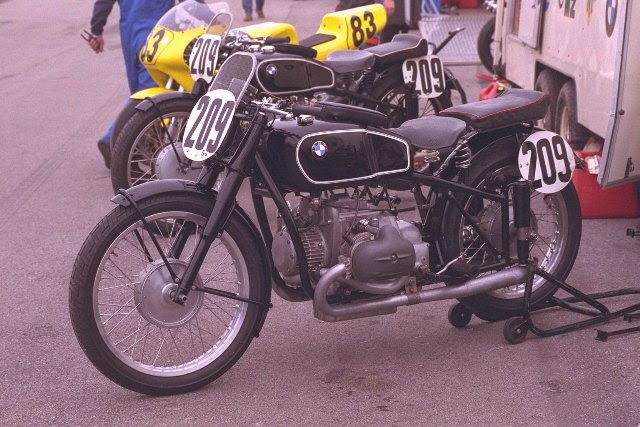Not too much commentary for these bikes. Enough has been written in various publications about the history of the bikes, and their triumphs before the war when the use of the Kompressor was still sanctioned. Here are some assorted pics of various BMW kompressor machines with close-up detail you can't find in the books. The first bike is in the BMW Museum in Munich.
 |
| Aluminum bars. Split fuel tank with left and right sides that bolt together in the middle. R. Muhle tachometer. |
As is commonly known, the so-called plunger frame bikes have no true dampening at the rear. There is only a spring on the left and right. As such, many works bikes incorporated a friction dampener to the rear to try to combat some of the bounce. Hidden in this photo behind the rear spring is a metal post that runs from the rear axle to the rear arm of the scissor dampener which you can see mounted to the rear frame tube. Just like the steering dampeners, one can increase or decrease the amount of friction by tightening or loosening the knob. The same round friction disks were used for the steering and the rear suspension. (The vertical metal post and tube attached to the axle in this picture are for suspending the bike as part of the display at the BMW Museum.)
 |
| Notice on the rim the four dots. These are rivets where the rim was seamed together. This is a steel wheel. The R51RS used a similar seam and rivet design, although in aluminum. |
 |
| Notice the removeable frame reinforcing tubes on the side of the frame. Attached obviously with bolts as there removal is required to pull the transmission or motor. The rear set of pegs is obviously not for a passenger! |
 |
| Single Amal Fischer carburetor feeding the kompressor. |
 |
| Sprung drilastic saddle. Partial view of "rennbrotchen". |
 |
| Accomodation for spare plugs, including wrench. Actually the plugs weren't spares. They used one heat range for warm up and another for the race. This backfired, no pun intended, at one important venue when the threads in the heads were stripped while attempting to swap the plugs right before a race. Bosch FJ2 type magneto. Note that the crank case, and transmission are made of Elektron, a light magnesium alloy. |
 |
| "Lightened" brake pedal and hand shift lever. |
This next bike is in the collection of the Zweirad Museum in Neckarsulm, Germany. It's a bit of an amalgamation of parts, some things were changed over the years, such that its not all period correct. Still, any BMW collector would love to have it, including me! These practically never change hands.
 |
| Nice view of the "Koenigswelle" or King Shaft that drives the overhead cams via bevel gear. Amazing that this is 1930's technology. It was reintroduced in the 1950's with the RS54 and its precursors. And the design was recently used again with the latest generation of DOHC motors used on the HP2 Sport and subsequently the R1200GS. |
The third bike is one that was, for a time, here in the US. It was sold a couple of years ago to a wealthy collector in Germany. The last time I saw it, it was in a thousand pieces being reverse engineered to make a small series of replicas.
 |
The fourth bike needs no introduction, the ex-Meier, ex-Surtees 1939 TT winning kompressor in the collection of BMW in Munich.
|

























Replicas? Where can I get one?
ReplyDeleteHELLO
ReplyDeleteLOVE THE SUPER CHARGED RACE BMW.
DO YOU KNOW WHO OWNS THE WALTER ZELLER
SUPERCHARGED STREET BMW THAT I HEARD IS FOR SALE?
THANK YOU
mikei750@yahoo.com
There was an article about this bike recently in one of the BMW magazines. The history of how the bike was acquired seems mired in mystery. Its not clear that everything was on the up and up. As such, most European collectors don't want anything to do with it. And the asking price has varied from several hundred thousand dollars to several million dollars. Last I heard the bike was still for sale.
DeleteThanks for the great photo layout. I notice that on some of the bikes the exhaust on the right hand side exits to the rear - or am I wrong? The inlet would then be facing the front - forced draught?
ReplyDeleteA good observation, but incorrect. The exhaust exits the front of the heads on both sides. What you see is the intake pipe leading to the rear of the heads from the kompressor. The pipes look similar to exhaust pipe, but these are bringing fuel into the combustion chamber. When kompressor were banned by the FIM, they removed the kompressor and associated intake pipes and mounted carburetors.
DeleteFantastic! Thanks for sharing!
ReplyDelete